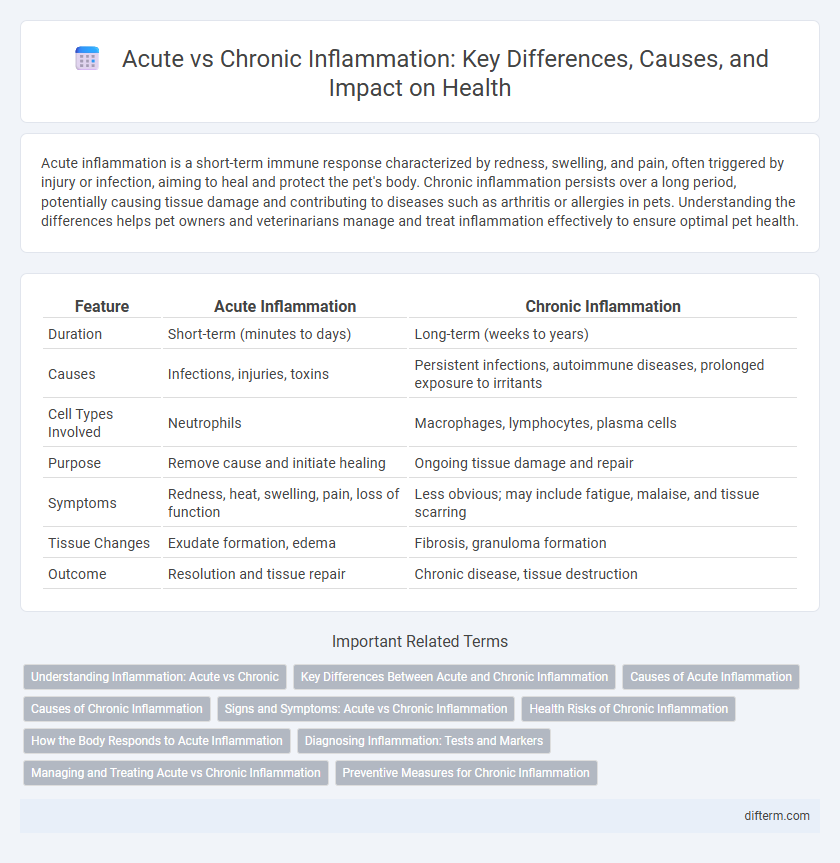Acute inflammation is a short-term immune response characterized by redness, swelling, and pain, often triggered by injury or infection, aiming to heal and protect the pet's body. Chronic inflammation persists over a long period, potentially causing tissue damage and contributing to diseases such as arthritis or allergies in pets. Understanding the differences helps pet owners and veterinarians manage and treat inflammation effectively to ensure optimal pet health.
Table of Comparison
| Feature | Acute Inflammation | Chronic Inflammation |
|---|---|---|
| Duration | Short-term (minutes to days) | Long-term (weeks to years) |
| Causes | Infections, injuries, toxins | Persistent infections, autoimmune diseases, prolonged exposure to irritants |
| Cell Types Involved | Neutrophils | Macrophages, lymphocytes, plasma cells |
| Purpose | Remove cause and initiate healing | Ongoing tissue damage and repair |
| Symptoms | Redness, heat, swelling, pain, loss of function | Less obvious; may include fatigue, malaise, and tissue scarring |
| Tissue Changes | Exudate formation, edema | Fibrosis, granuloma formation |
| Outcome | Resolution and tissue repair | Chronic disease, tissue destruction |
Understanding Inflammation: Acute vs Chronic
Acute inflammation is a short-term, immediate response to injury or infection, characterized by redness, swelling, heat, and pain, aimed at eliminating harmful stimuli and initiating tissue repair. Chronic inflammation persists over a longer period, often due to unresolved acute inflammation or autoimmune conditions, leading to tissue damage and increased risk of diseases such as arthritis, cardiovascular disease, and cancer. Understanding the distinct mechanisms and effects of acute versus chronic inflammation is crucial for developing targeted treatments and improving patient outcomes.
Key Differences Between Acute and Chronic Inflammation
Acute inflammation is a rapid, short-term response to injury or infection characterized by redness, heat, swelling, and pain, aiming to eliminate the offending agent and initiate healing. Chronic inflammation persists over months or years, often due to unresolved acute inflammation or autoimmune reactions, leading to tissue damage and contributing to diseases like arthritis, cardiovascular disease, and cancer. Key differences include duration, cellular components involved, with neutrophils predominant in acute inflammation and macrophages and lymphocytes in chronic inflammation, as well as the underlying causes and outcomes of the inflammatory process.
Causes of Acute Inflammation
Acute inflammation is primarily triggered by infections, physical injuries, or exposure to harmful agents such as toxins and chemicals. The immune system responds rapidly to remove pathogens and damaged cells, initiating tissue repair processes. Typical causes include bacterial infections, burns, cuts, and allergic reactions that activate the release of inflammatory mediators like histamine and cytokines.
Causes of Chronic Inflammation
Chronic inflammation is primarily caused by persistent infections, prolonged exposure to irritants such as industrial chemicals or damaged cells, and autoimmune diseases where the immune system mistakenly attacks healthy tissues. Lifestyle factors including poor diet, chronic stress, obesity, and smoking also contribute significantly to maintaining low-grade chronic inflammation. Unlike acute inflammation, which is a short-term immune response, chronic inflammation leads to ongoing tissue damage and is linked to conditions like arthritis, cardiovascular disease, and diabetes.
Signs and Symptoms: Acute vs Chronic Inflammation
Acute inflammation is characterized by rapid onset of redness, heat, swelling, pain, and loss of function at the affected site, serving as the body's immediate response to injury or infection. Chronic inflammation manifests with persistent symptoms such as prolonged swelling, fatigue, fever, and tissue destruction, often linked to autoimmune diseases or unresolved infections. Distinguishing between acute and chronic inflammatory signs is critical for accurate diagnosis and effective treatment strategies in clinical practice.
Health Risks of Chronic Inflammation
Chronic inflammation poses significant health risks by contributing to the development of diseases such as cardiovascular disease, diabetes, rheumatoid arthritis, and certain cancers. Unlike acute inflammation, which is a short-term protective response, chronic inflammation persists over months or years, damaging tissues and organs. Elevated levels of inflammatory markers like C-reactive protein (CRP) and interleukin-6 (IL-6) are linked with higher risk of metabolic syndrome, neurodegenerative disorders, and autoimmune conditions.
How the Body Responds to Acute Inflammation
Acute inflammation triggers a rapid immune response characterized by increased blood flow, capillary permeability, and migration of neutrophils to the injury site, facilitating the elimination of pathogens and damaged cells. Pro-inflammatory cytokines such as tumor necrosis factor-alpha (TNF-a) and interleukin-1 beta (IL-1b) regulate this process to contain and resolve the injury. This coordinated response promotes tissue repair and restores homeostasis within days if the cause is successfully eliminated.
Diagnosing Inflammation: Tests and Markers
Diagnosing inflammation involves measuring specific biomarkers such as C-reactive protein (CRP) and erythrocyte sedimentation rate (ESR), which are elevated in both acute and chronic inflammation. Acute inflammation typically shows a rapid spike in inflammatory markers alongside symptoms like redness, swelling, and pain, while chronic inflammation may exhibit persistently elevated markers without overt symptoms. Advanced tests like cytokine profiling and imaging studies further help differentiate between acute and chronic inflammatory states by assessing tissue involvement and immune response patterns.
Managing and Treating Acute vs Chronic Inflammation
Managing acute inflammation primarily involves rest, ice, compression, and elevation (RICE) alongside nonsteroidal anti-inflammatory drugs (NSAIDs) to reduce pain and swelling. Chronic inflammation requires a comprehensive approach including lifestyle modifications, such as diet rich in antioxidants, regular exercise, stress management, and potentially long-term use of anti-inflammatory medications or biologics to control underlying conditions. Monitoring biomarkers like C-reactive protein (CRP) and erythrocyte sedimentation rate (ESR) aids in assessing treatment effectiveness and adjusting therapeutic strategies.
Preventive Measures for Chronic Inflammation
Chronic inflammation can be effectively prevented through lifestyle modifications such as maintaining a balanced diet rich in antioxidants, regular physical activity, and stress management techniques. Avoiding exposure to environmental pollutants, quitting smoking, and limiting alcohol intake also play crucial roles in reducing chronic inflammatory responses. Early diagnosis and management of underlying conditions like obesity, diabetes, or autoimmune diseases further decrease the risk and progression of chronic inflammation.
Acute Inflammation vs Chronic Inflammation Infographic

 difterm.com
difterm.com